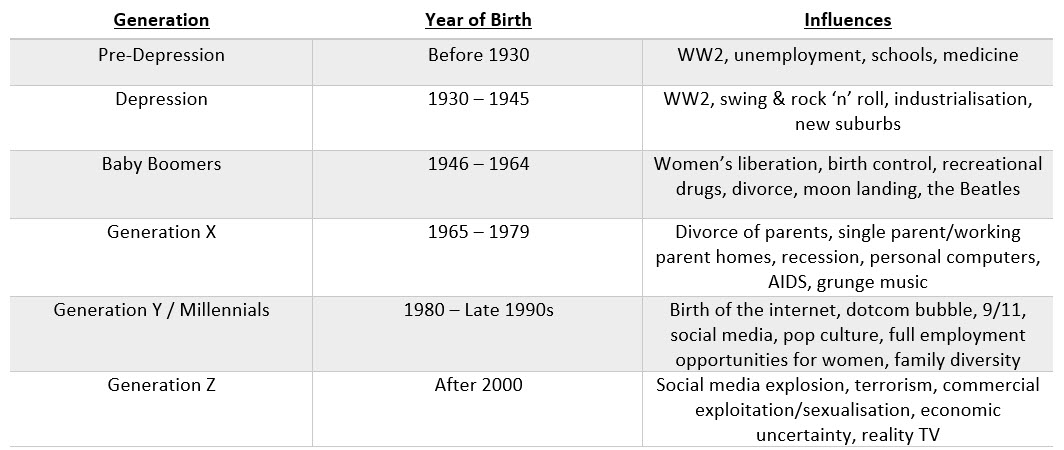Multi-generational marketing is a must for every brand. The days of using a ‘one size fits all’ marketing approach for an entire population are long gone, and you should now tailor your branding and marketing techniques to a distinct consumer generation society.
The Consumer Generations
In today’s society it very multi-generational. There are currently six generational segments, though the years which divide them are only guidelines. Some consumers may fall into more than one category:

Each of these generations has its unique characteristics, values and needs. These are shaped by the years that they were born and grew up in. Whilst the population; specifically in the western world; each one spans roughly 15 years so differences within them can be seen grouped into these six categories.
Marketing to the Generations
You must truly understand the characteristics of each individual group to develop an effective marketing strategy. You should know how the key experiences of each generation influences how the people within it want to receive marketing messages.
Pre-Depression Generation:
Born before WW2, the Pre-Depression Generation experienced difficult economic times as children. These had high unemployment rates and traumatic ordeals. This generation has seen radical social and technological changes across their lifetime; and are more conservative as a result. As an aging group, they are decreasingly materialistic; concerned more with health, and many suffer from memory loss or a long-term illness. They seek financial and personal security.
Depression Generation:
The Depression Generation were small children during WW2. Rationing and saving are of high importance to them. Having generally relied on tried and tested methods, they also value morals and ethics and are averse to change,. They are unlikely to disrespect authority. Family is important to this generation and many are now grandparents who are fairly active. Whilst they have wealth in the form of home equity; they worry that they will outlive their savings. They are concerned about being dependant on others, and are becoming increasingly more tech savvy.
To market to this generation, you should not depict them as dependant. Instead, emphasise active lifestyles and traditional attitudes e.g. hard work and responsibility, and stress simplicity, convenience and service. Be formal with this generation. Earn their trust and they will be loyal. Present easily digestible, non-confrontational information to them through traditional media like radio, TV and direct mail. Research and design websites specifically for them.
Baby Boomers:
This generation were born during the large increase of births after WW2. Valuing individualism and optimism, they are workaholics; defined by their careers. Baby Boomers are the parents and grandparents of the youngest generations (who have the most buying power) and are the Sandwich Generation; caring for both their kids and ageing parents. Sometimes these are are considered self-centred. They are highly educated, suspicious of authority and are concerned with aging. Health foods, products and treatments are of interest to this segment.
Communicate with Boomers via social events, email and television. Give them recognition and gratification, i.e. “we need you”, with positive messages. The enjoy the internet for convenience and social networking, though they need lots of information when deciding, and prefer text to images.
Generation X:
Gen X are the least traditional generation. They are rebellious, and embrace freelance lifestyles over company loyalty; nothing is permanent to this generation. They can be pessimistic and sceptical, valuing their own time. They experienced the rise of personal computers and highly value technology, considering it life changing.
To sell to Generation X is to not sell, but to consult. They are dubious of advertising and respond better to a candid, informal communication style. Maintain a relationship with them by asking for their feedback and providing them with information: educate them into consuming.
Generation Y:
Commonly known as Millennials, this is the most diverse demographic.Research suggests that there are up to 12 segments within the generation itself. Millennials are the largest consumer group and have revolutionised marketing. Focused on online engagement, they’ve forced brands to embrace social media and blogs in order to reach them. Having grown up with the rise of the internet. They are tech-savvy and independent, and many are focused on experiences. Concerned with social, environmental and community issues and gender equality, they value truly authentic brands.
Generation Y does their research when purchasing. However, they spend on unnecessary ‘necessities’, fuelling coffee shop culture. They highly regard the opinions of individuals they trust or admire. This means linking your brand to a social media influencer could hugely benefit brand recognition with Millennials. To attract Generation Y, provide information in short messages or visual content.
Generation Z:
The youngest generation, sometimes referred to as the Net Gen, has never lived without the internet. They have been raised on smartphones and social media. Often using multiple devices at once. They are street-smart, but terrorism has made them cautious and exploitation makes them insecure. This generation need to belong and the approval of peers is important. Therefore they are brand conscious. Generation Z see multiculturalism as the norm and they value equality. That is to say, they have huge amounts of buying power and strongly influence their parents’ purchasing habits (“kidfluence”). These are not to be ignored by marketers.
In conclusion, you should aim to earn the loyalty of this demographic early on, as their parents and grandparents frequently buy them high-quality goods. Money is currently not an issue. Firstly, partner with respected online brands and moderate any chat facilities. Secondly, make sure they are safe with your brand. Lastly, speed in communications is a must. Respond within 24 hours to any communications with Gen Z otherwise they will switch off to you. Regularly generate fresh and exciting content to keep them engaged.






